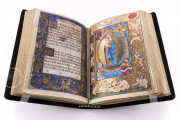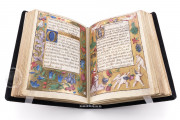Representing the highest level of elite patronage, the German Prayer Book of the Margravine of Brandenburg is a remarkable monument of Augsburg illumination. Made in 1520, this manuscript is illustrated by forty-seven radiant miniatures rendered in costly pigments and generously bathed in brilliant gold.
The grandiose manuscript contains a unique, personalized selection of Christian devotional texts in German, beginning with prayers addressed to the Virgin Mary, the Archangel Michael, Saint John the Evangelist, and Saint Andrew. A collection of luscious borders frames both text and image on more than 200 of its pages. The borders feature a variety of styles such as the Ghent-Bruges floral border particularly prized in Flemish illumination, along with blossoming acanthus borders typical of Augsburg illumination, semi-grisaille displays of worldly goods, and combinations fashioned from these traditions.
Sacred and Secular Images
A mere eighteen years old at the time of this commission, the Augsburg artist Narziss Renner outfitted the manuscript with an impressive array of miniatures. Emotive devotional compositions are beautifully paired with secular motifs. Groups of putti (naked children) frolic in the borders along with grotesques and animals. The figures, real and imagined, are often playful and always engaging, as, for example, is a cat having caught a mouse pictured in the border of fol. 25v. The book is notable for its image of a stag hunt (fol. 42r) held in connection with the wedding festivities of the first owner of the book.
The longest single text is a series of twenty-four hourly devotions focused on the Passion of Christ (fols. 28v-64v). The twenty-five miniatures interspersed through the text—most full-page—constitute an extensive Passion cycle, one that frequently focuses the devotee's attention on the extremity of Christ's tortures and his bleeding body.
Written in the Vernacular
The customized selection of texts written in German rather than Latin contributes to the intimacy of this book. The codex was thus meant to be used daily to guide the devotion of its user in the most immediate way. The text is appropriately written in Fraktur, a script special to the wide German-speaking network in the sixteenth century and beyond. Some of the texts were supplied later in a cursive script in spaces left blank for them.
Made for an Aristocratic Woman
The prayer book is dated in numerous places to 1520 and contains images of its intended owner, Susanna of Bavaria, Margravine of Brandenburg-Kulmbach. Susanna was the niece of Emperor Maximilian I. The manuscript was likely made as a gift to celebrate her marriage to Casimir, Margrave of Brandenburg-Bayreuth, in 1518. Their double portrait is found on fol. 183r. The book continued in the family and was later owned by their third daughter Kunigunde of Brandenburg-Kulmbach (1524–1558), Margravine of Baden-Durlach. The notes and family tree inserted at the end of the book demonstrate that it became a treasured repository for family memory.
Luxuriously Bound
Unsurprisingly, the regal book was endowed with a correspondingly stately binding. Its wooden boards are covered in black velvet and lined in green silk. Gilt silver bosses ornament both boards and are arrayed around central enamel medallions bearing the Bavarian coat of arms.
We have 1 facsimile edition of the manuscript "German Prayer Book of the Margravine of Brandenburg": Das Deutsche Gebetbuch der Markgräfin von Brandenburg facsimile edition, published by Faksimile Verlag, 2002
Request Info / Price


















